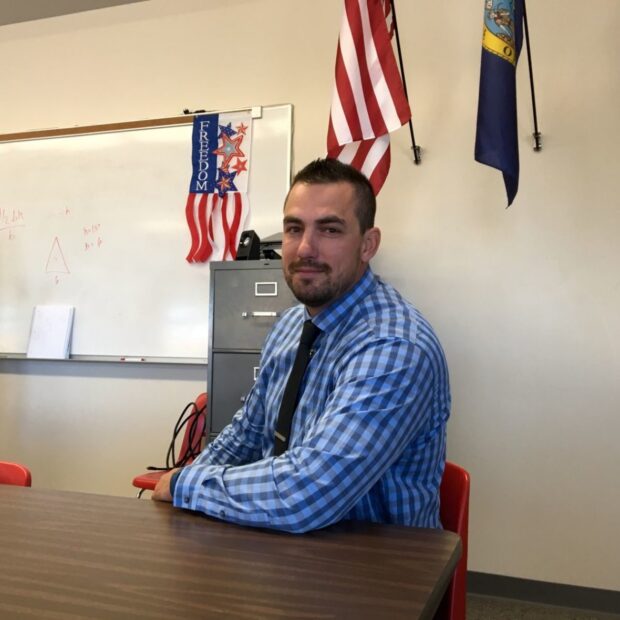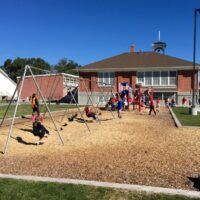The emphasis on patriotism is clear the moment you walk into American Heritage Charter School in Idaho Falls. Flags drape the hallways. Pictures of the nation’s founders line the classroom walls. Students adhere to a red, white and blue dress code.
It’s all part of the school’s goal to create patriotic and educated leaders.
The school also hopes to have all of its roughly 250 students ready to enroll in college or some form of postsecondary school by the time they graduate.
To help make that happen, American Heritage is embracing the state’s first wave of mastery-based programs.
“It’s something we’re very excited about,” said principal and math teacher Shawn Rose.
Last year, the State Department of Education called for 20 statewide “incubators” or pilots aimed at providing mastery-based programs to students in 2016-17. As a result, American Heritage and 18 other Idaho schools were granted access to $1.4 million in state funds set aside for creating the programs. American Heritage requested and will receive some $55,000 to implement its mastery-based model this year.
At the end of the school year, American Heritage and other participating schools will provide data to the state, including evidence of improved instructional practices, end of course tests and graduation data. Pilots may also be asked to “participate in site visits, interviews and focus groups, as well as provide documentation or other artifacts of the planning, design, or implementation process for use in evaluation,” according to the Idaho Department of Education’s website. The state will use that information to gauge future implementation of statewide mastery-based methods.

Under a mastery-based system, students no longer advance from grade to grade based on seat time or by receiving a passing mark. Instead, they move on once they have demonstrated mastery of all the concepts covered in a class or grade level.
The learning approach is a perfect fit for students at American Heritage, Rose said.
“Really, it’s something we’ve already been implementing here,” he said.
Last year, the school purchased enough computers to develop a blended, or partially online, curriculum for its high school age students. The one-to-one ratio of students to computers will play a big part in American Heritage’s mastery pilot and postsecondary-enrollment emphasis, Rose said.
“Kids take the time they need to develop understanding of the standards,” he said, “even if the work has to extend into the summer time or even into the next school year.”
To advance in their mastery-based coursework, American Heritage students must meet a mastery-based threshold of 80 percent on their assessments in 2016-17.
American Heritage’s mastery pilot
The first thing American Heritage students do is take a test, or placement exam, to see which Common Core Standards they’ve already mastered.
From that test, teachers develop an online learning framework using software called Learning Management System. Each student has their own account, with assignments, activities and assessments that emphasize the individual’s unmastered standards.
“Why should a student sit in a classroom for four to six weeks learning material they already know?” Rose said.
Students access their personalized curriculums on their individual laptops. The software’s color-coated advancement system let’s them know which standards they have yet to start (red), which ones they’re making progress on (yellow) and which ones they’ve completed (green).

Teachers assume the role of overseers at the school, spending the majority of their time on their feet, coaching and mentoring instead of lecturing, and keeping tabs on students, making sure they stay on track.
“We teach the kids to take ownership of their learning,” said Rose. “That’s one of the reasons a mastery-based system works here — it encourages them to stay on top of their own stuff.”
Students have the freedom to set their own schedules and spend time working on subjects requiring the most attention, though they still have a class schedule.
As a result, teachers gauge the learning needs of students. If one asks to leave class to work on something else, Rose said, they are usually given permission.
To help oversee an unusual amount of autonomy, students are each assigned a teacher-mentor, whom they meet with weekly to plan for upcoming assignments.
On top of that, the school employs an academic coach who reinforces the process by helping out when mentors can’t.
Junior, Carissa Jacobson, likes the mastery-based model and says its flexibility has given her a chance to rise to the school’s challenge to earn college credits. The program has also given her extra time to focus on her most demanding coursework, she said.
Last year, Jacobson fell behind in math due to a dual-enrollment history class. Instead of cramming to get a grade she didn’t want, she visited with her mentor to develop a plan. As a result, she was able to complete her math coursework the following year, without penalty.
“It works both ways — we get to move forward or get help when we need it,” Jacobsen said.
The biggest challenge is helping parents and guardians understand that their students can have the extra time when they need it.
“Parents can get a little confused, which is why we have to make sure we communicate with them carefully,” Rose said. “They often have the attitude that the traditional pass-fail system worked for them, so it should work for their kids. But, I say, if we want our kids to accomplish more than us, why have them do the same things we did?”
American Heritage produced some of the state’s best ISAT scores in 2014-15 but showed declines during the latest round of testing in 2015-16, with a six-point drop on the math portion of the test and a seven-point drop in English Language Arts.
Rose acknowledged the drop and attributed it to implementation of last year’s blended education model.
“The test results were a concern,” he said.”But the major concern comes if we see the same dip over an extended period of time, not on just one round of tests.”
ELA scores generally improved in the higher grades across the state this year, while only 31 percent of high school students scored advanced or proficient in the math SBAC — a modest improvement from 2015’s 30 percent proficiency rate.
American Heritage students tallied 49.4 percent proficiency in math and 58.7 percent in ELA.
Rose said American Heritage will be implementing a new batch of “data driven instruction” this year, including online math software called Math Facts, which encourages students to formulate math problems in their heads instead of having to use a calculator.
But students’ abilities to advance in the dual enrollment coursework is the best indicator of the school’s success, Rose said.
“The more they can perform well in advanced classes is how we will know the program is working. If they are taking college classes here and they are doing well, we’ll know,” he said.
Only American Heritage students engaged in coursework for grades 9-12 are taking part in this year’s mastery pilot. The school’s elementary and junior high students participate in a more traditional curriculum, though that could change soon, with Rose and other teachers currently considering ways to develop a mastery-based program for the school’s younger learners.
The state earmarked a portion of American Heritage’s $55,000 for purchasing computers. However, because the school already has a one-to-one ratio of computers to students, Rose said he’d like to spend the money on extra personnel to support the program, more training for teachers and better curriculum development.
The school is located in Idaho Falls and serves about 250 kids. It operates under the Idaho Public Charter School Commission.
Idaho’s future with mastery-based learning
Establishing pilot programs like the one at American Heritage will enable the state to collect feedback on how to implement mastery-based learning in the future, said State Department of Education director of mastery-based learning Kelly Brady.
“We have to remember that this is a generational thing – it’s going to take years, maybe even decades, to get into place,” she said.
Brady referred to states such as New Hampshire, which has been working to implement mastery-based models for nearly 10 years.
“It’s still not happening in many regards in some of those areas,” she said. “But many colleges and universities have adjusted their acceptance criteria to mastery-based models.”
For now, she said, the pilot programs are about local control and learning what works and what doesn’t.
